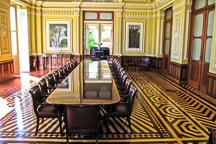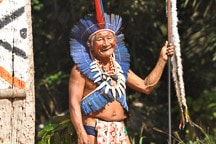Manaus, Amazonas Brazil
“Gateway to the Amazon”
You have been flying for over 2 hours since hitting the South American coast flying from Miami and all you have seen out the window is untouched jungle and sandbar infested rivers. The pilot comes on the intercom and says he is beginning the descent into Manaus. Descending from 35,000 feet to 3,000 feet you still see no signs of civilization. Then suddenly without any warning, Manaus a city of 2 million on the shores of the Rio Negro, appears from the middle of the rain forest! Located 900 miles up the Amazon River from the Atlantic Ocean, Manaus has been the gateway to the Amazon since it was established as the Fort of Sao Jose do Rio Negro by the Portuguese in 1694. Located at the confluence of the Rio Solimoes, commonly called the upper Amazon River, and the black watered Rio Negro, it has long been strategically important as the economic hub of Brazil’s Amazon. Manaus came into prominence and was known as the “Paris of the Tropics” during the rubber boom of the late 1800’s as many prominent and wealthy European families settled there. No extravagance was too great as can still be seen 125 years later in the opulent Opera House, the historic Governor’s Mansion and several other structures in the city. In decline in the early and mid-1900’s, Manaus has grown into a thriving economic center again. It was named Brazil’s first “free port” for industrial manufacturing during the close of the century and now is home to over 300 of the worlds largest manufacturing firms. This thriving city, in the middle of the Amazon rain forest, is the capital of the state of Amazonas and the gateway to ecological wonders and world renown Peacock Bass fisheries. Manaus was a quarterfinal host to the 2014 FIFA World Cup Soccer games for which a beautiful new soccer stadium was built downtown and much of the area around the stadium has been rebuilt and modernized. As Peacock Bass fishing has increased in popularity over the last 20 years, Manaus has become familiar to many traveling American anglers.
Sites In & Around Manaus
It is well worth your while to spend a day in Manaus at the beginning or end of your trip at some or all of the sights described below. You will want to have dinner at an authentic Brazilian Churrascaria restaurant in Manaus where they keep bringing slabs of char broiled meats cooked in the classic Brazilian style until you burst!
Teatro Amazonas
The crowning jewel to the extravagance left by the Rubber Barons of the Amazon in the late 1800’s is the opulent opera house built in Manaus in the late 1800’s at a then unheard of cost of 10 million dollars. The Italian architect Celestial Sacardim was commissioned to design the Theater Amazonas in the Renaissance style of Europe. One of the worlds classic opera houses, it features seating for over 700, was completed in 1892 at a cost of $10 million dollars, is constructed with bricks from Europe, French glass and Italian Marble featuring gilded balconies and has electrical lighting which was unheard of at the time. Over the years important opera and theater companies, as well as international orchestras have performed there. It is home to the Amazonas Philharmonic Orchestra and operas are still being performed. This is a must see when you are in Manaus and guided tours are available on a daily schedule.
Soccer Stadium
This modernistic Soccer stadium was built over the last 4 years for the World Cup quarterfinal soccer games hosted by Brazil in 2015.
The Open Market
The Mercado Adolpho Lisboa founded in 1882, a copy of Paris’ famous Les Halles market place, is another of the historic landmarks in Manaus. A wide variety of the 2,500 different species of fish from the Rio Negro and Amazon Rivers as well as exotic fruits and vegetables from the surrounding farms and rain forest makes this one of the cities premier tourist attractions. If you wish to experience the look and feel of the old Amazonia market place on the river wharf, this is an excursion you do not wish to miss.
The Governor's Mansion
Other interesting historical sites include the Governors mansion featuring intricate parquet floors and furniture built over 100 years ago from native woods that no longer can be found and the historic square where it is located.
Other Excursions
There is even a place on the river where you can swim with the wild pink and gray dolphins that are indigenous only to the Amazon River Basin. There is also the famous “Meeting of the Waters” just 11 miles downriver from Manaus where the muddy waters of the Rio Solimoes meets the black water of the Rio Negro as they travel together for 6 – 8 kilometers before joining into one homogeneous river, the Amazon.
Performances by Indigenous People
There are several villages of indigenous Indians that can be visited on day trips from Manaus that do performances of their ancestral dances and rituals. Several tour operators offer these trip allowing you to experience the age old tribal customs, apreal and dances of the indigenous Indians of Brazil’s Amazon.


















